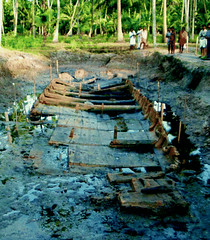The discovery of the 11,000 year old temple at Gobekli Tepe in Turkey raised an important question: Did complex societies arise after the discovery of agriculture or vice versa?
Scholars have long believed that only after people learned to farm and live in settled communities did they have the time, organization and resources to construct temples and support complicated social structures. But Schmidt argues it was the other way around: the extensive, coordinated effort to build the monoliths literally laid the groundwork for the development of complex societies. The immensity of the undertaking at Gobekli Tepe reinforces that view[Gobekli Tepe: The World’s First Temple? | varnam]
The discovery of a 12,000 year old female shaman grave in Israel, 1000 years older than the stonehenges at Gobekli Tepe, supports the idea that complex societies arose before farming.
Agriculture was not established in the Levant when the Natufians lived there, but they still erected rudimentary structures to inhabit. Traces in the soil of the remains of mice and sparrows — animals that exist most commonly in places of human settlement — point to a significant population boom in the Natufian period. They may not have had seasonal harvests, but the people of this time lived in a complex and perhaps even flourishing society.[12,000-Year-Old Shaman Unearthed in Israel – TIME]

